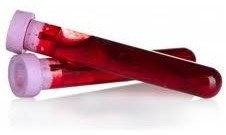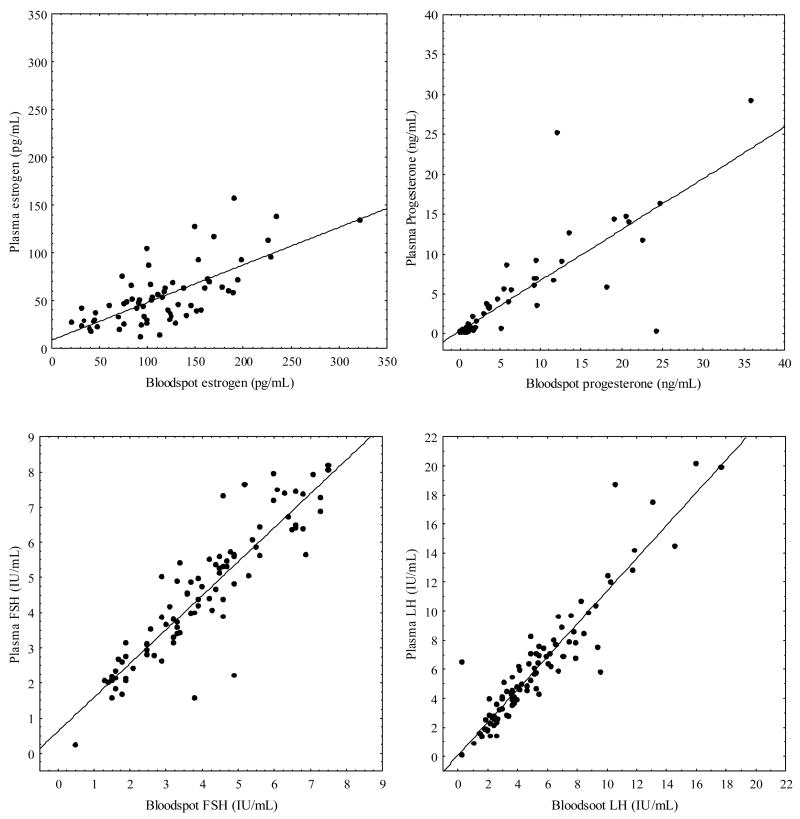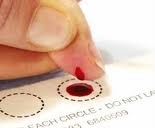Hormone Testing Primer
 A lot of women as well as men ask their doctor to check their hormone levels as a cause for low energy and lack of zest for life as they get older. Many of these women and men are getting on bio-identical hormones, and the hormone levels must be monitored. In addition, hormone testing can help diagnose female problems in menstruating women.
A lot of women as well as men ask their doctor to check their hormone levels as a cause for low energy and lack of zest for life as they get older. Many of these women and men are getting on bio-identical hormones, and the hormone levels must be monitored. In addition, hormone testing can help diagnose female problems in menstruating women.
The question is – what kind of test will best reflect the tissue levels of the hormones? The tissue level is where we want the hormone action, and we do not routinely sample tissues directly to measure the amount of hormones effectively acting on the cells. We have seen in research studies that the estrogens, progesterone, and testosterone given as a medication can helps resolve some pathological processes and improve mood and energy.
 So . . . do we test blood serum, saliva, urine or capillary blood for the best results? When does it matter? And when can we avoid a blood draw involving a needle stick and use the less invasive methods: saliva, urine and capillary blood (blood spot)?
So . . . do we test blood serum, saliva, urine or capillary blood for the best results? When does it matter? And when can we avoid a blood draw involving a needle stick and use the less invasive methods: saliva, urine and capillary blood (blood spot)?
Finally, do testing methods differ depending on the route of administration of hormone medications?
 This article outlines the answers to all these questions, and gives references to show when it makes a difference. I give a special thanks to David T. Zava, PhD of ZRT Labs for the research he and his lab has done and for sharing the results with health care professionals.
This article outlines the answers to all these questions, and gives references to show when it makes a difference. I give a special thanks to David T. Zava, PhD of ZRT Labs for the research he and his lab has done and for sharing the results with health care professionals.
I am starting backwards by stating the conclusion, then going on to explain and show research that backs it up. If you just want the bottom line, it follows. If you have more curiosity, read on.
When testing the baseline hormone levels of a woman or man, it does not matter which kind of test you use: blood serum, saliva, urine, or blood spot.
When testing hormone levels of patients using supplemental hormones, the results vary drastically depending on the testing method and route of administration of the hormones. The details are in the following chart.
Guide to Steroid Hormone Testing in Different Body Fluids following Different Routes of Hormone Administration
Body Fluid Baseline Oral Topical Vaginal Sublingual Pellet/IM
Serum Yes Yes (1) No (2) No (2) Yes Yes
Saliva Yes Yes (3) Yes (3) Yes No (4) Yes
Urine Yes Yes (1) No (2) No (5) Yes Yes (3)
DBS Yes Yes Yes (6) Yes Yes Yes
1) Overstimulation: Metabolites interfere with immunoassays
2) Understimulation: Hormone levels not reflective of tissue uptake
3) Overstimulation: Requires range adjustment
4) Overstimulation: Direct contamination of oral mucosa/saliva
5) Overstimulation: Direct contamination of urine
6) Overstimulation: IF fingertips contaminated with topical hormone
The Route of Administration of Hormones can skew results due to contamination
 Hormones administration can contaminate test samples in these cases:
Hormones administration can contaminate test samples in these cases:
- Sublingual hormones or troches can contaminate saliva samples.
- Topical hormones given vaginally can directly contaminate urine.
- Topical hormones can affect Blood Spot testing IF the fingertips are contaminated.
Topical Hormones show up too low in Blood Serum and Urine Samples
We need to have a hormone test which accurately reflects how much hormone is active in the tissue, not how much is circulating in the blood. When a blood serum or urine test shows hormone levels from topically delivered hormones, it can be ten times less than what is getting into the tissues. This can lead to an overdose of hormone if the prescription is based on one of these two tests.
Menopause. 2013 May 6. [Epub ahead of print]
Percutaneous progesterone delivery via cream or gel application in postmenopausal women: a randomized cross-over study of progesterone levels in serum, whole blood, saliva, and capillary blood.
Du JY, Sanchez P, Kim L, Azen CG, Zava DT, Stanczyk FZ.
CONCLUSIONS: After application of topical progesterone, saliva and capillary blood levels are approximately 10-fold and 100-fold greater, respectively, than those seen in serum or whole blood. High capillary blood and saliva levels indicate high absorption and transport of progesterone to tissues. Reliance on serum levels of progesterone for monitoring topical dose could lead to underestimation of tissue levels and consequent overdose.
Response to Oral Administration of 100 mg of Progesterone
Conclusion: Majority (95+%) of oral progesterone is rapidly converted to inert progesterone metabolites in the GI tract and liver. These inactive metabolites interfere with the serum progesterone immunoassays, resulting in false-high values. Selective extraction methods are necessary to separate progesterone from its metabolites before progesterone can be accurately measured by immunoassay. More accurate testing can be done by extraction-LC/MS/MS methods.
Lab Tests Made Simple, David Zava, PhD
Hormone Testing in Urine Following Exogenous Oral Hormone
Testing of Urinary Pregnanediol in Postmenopausal Women at Different Phases of the Menstual Cycle and on Hormonal Contraceptives, and in Postmenopausal Women Supplementing with Topical, Vaginal, and Oral Progesterone
Conclusion: Majority (95+%) of oral progesterone is rapidly converted to inert progesterone metabolites in the GI tract and liver. These inactive metabolites never enter target tissues as active progesterone and are excreted into urine. LC/MS or GC/MS analysis of orally delivered progesterone indicates very high urinary levels, much higher than the luteal phase progesterone. This can lead to the false impression that oral progesterone raises systemic progesterone to levels seen during the luteal phase. Reference ranges should reflect higher levels.
Lab Tests Made Simple, David Zava, PhD
Blood Spot Testing Gives Accurate Results for all Delivery Forms of Hormone Medications
When given a choice, most patients will choose the less invasive testing. Blood spot testing involves only a finger prick where serum blood testing requires a needle stick in a vein and blood draw.
Serum Blood Tests Results Correlate with Blood Spot Capillary Blood Tests
 Blood Spot vs Serum Correlations of Estrogen, Progesterone, FSH, and LH hormones
Blood Spot vs Serum Correlations of Estrogen, Progesterone, FSH, and LH hormones
 Fertil Steril. 2007 Nov;88(5):1404-7. Epub 2007 Mar 26.
Fertil Steril. 2007 Nov;88(5):1404-7. Epub 2007 Mar 26.
A comparison of blood spot vs. plasma analysis of gonadotropin and ovarian steroid hormone levels in reproductive-age women.
Edelman A, Stouffer R, Zava DT, Jensen JT.
CONCLUSION(S): Blood spot monitoring of FSH, LH, P, and, to a lesser extent, E(2), appears to be as valid as traditional plasma assays for clinical research and care.
Conclusions
 If you are testing hormones as a baseline and do not ever intend to take exogenous hormones, then the kind of test which is done does not matter for the accuracy of the results.
If you are testing hormones as a baseline and do not ever intend to take exogenous hormones, then the kind of test which is done does not matter for the accuracy of the results.
If you are testing hormones with the treatment plan in mind of bio-identical hormones, the body fluid you choose to test is important. This is because the follow-up test may not be accurate, depending on the delivery form of the bio-identical hormone.
Oral hormones: Metabolites interfere with the hormones testing in blood serum and urine.
Stick to salivary testing if the range is adjusted, or blood spot testing.
 Topical hormones: Hormone levels do not reflect tissue levels in blood serum and urine testing.
Topical hormones: Hormone levels do not reflect tissue levels in blood serum and urine testing.
Stick to salivary testing or blood spot testing.
Vaginally administered topical hormones: Serum blood hormone levels are not reflective of tissue levels. Urine samples may be contaminated by the exogenous.hormones.
Salivary testing and Blood Spot testing will give the more accurate test results.
 Sublingual hormones or troches: Salivary testing may be contaminated by the hormones.
Sublingual hormones or troches: Salivary testing may be contaminated by the hormones.
Blood serum, urine or blood spot testing is more accurate.
Hormone pellets or intramuscular injection of hormones: Urine testing may need range adjustments due to metabolites.
Blood serum, salivary testing, and Blood Spot testing are valid.
Will You Choose Hormone Testing?
 A laboratory test is only useful if it gives information for a treatment plan. You may choose hormone testing for various reasons.
A laboratory test is only useful if it gives information for a treatment plan. You may choose hormone testing for various reasons.
Dr. Cheryl Kasdorf can help you determine is hormone testing is useful for your health condition.
She offers blood serum, Blood Spot, and salivary testing for baseline hormone levels. She can also prescribe bio-identical hormones and monitor your response with testing.
Call 928-649-9234 for a free 15 minute get-to-know-you appointment to find out what Dr. Cheryl might be able to do for you.
And . . . please leave a comment below if you found this information useful.
WANT TO USE THIS ARTICLE IN YOUR NEWSLETTER OR WEB SITE?
You can, as long as you include this complete blurb with it: “Naturopathic Physician Dr. Cheryl Kasdorf is a doctor who listens and has answers with a natural approach that works. She is known as the go-to person to get back your get-up-and-go when it is gone, gone, gone. Get your FREE gift “Dr. Kasdorf’s Health Secrets for Feeling & Looking Great” at drcherylkasdorf.com



